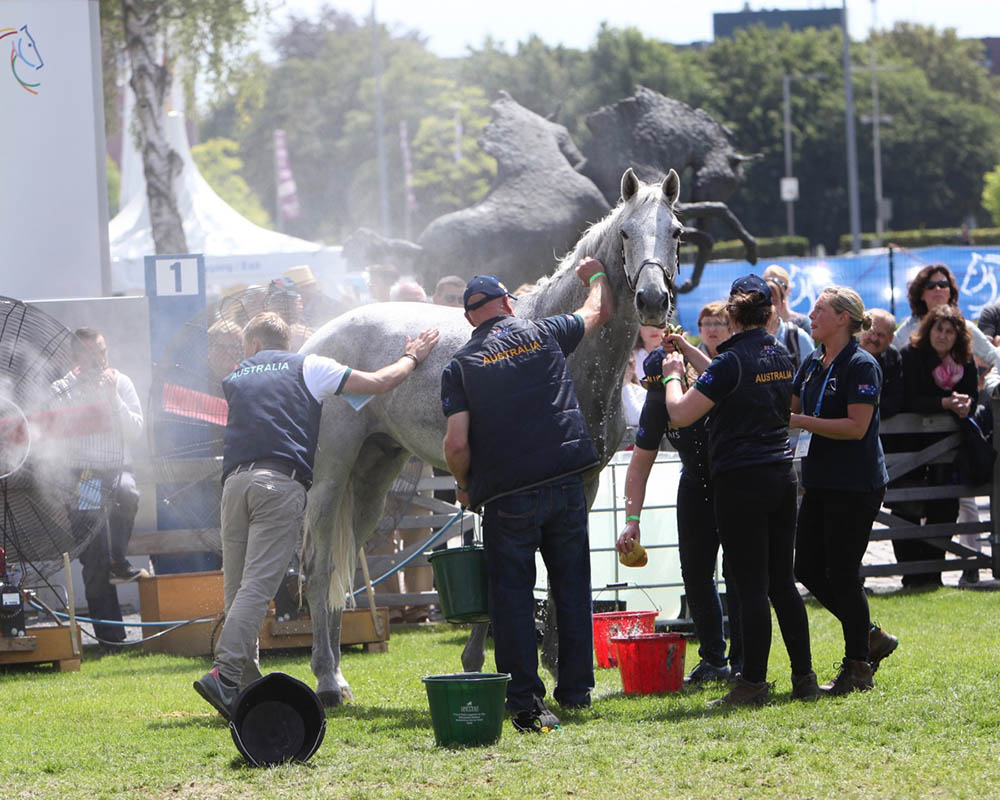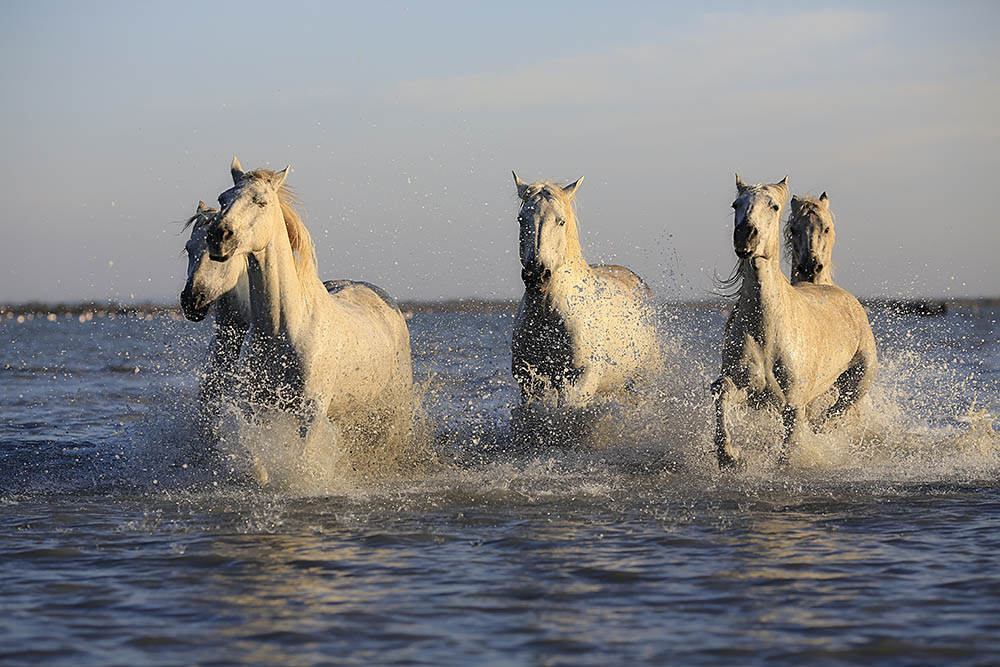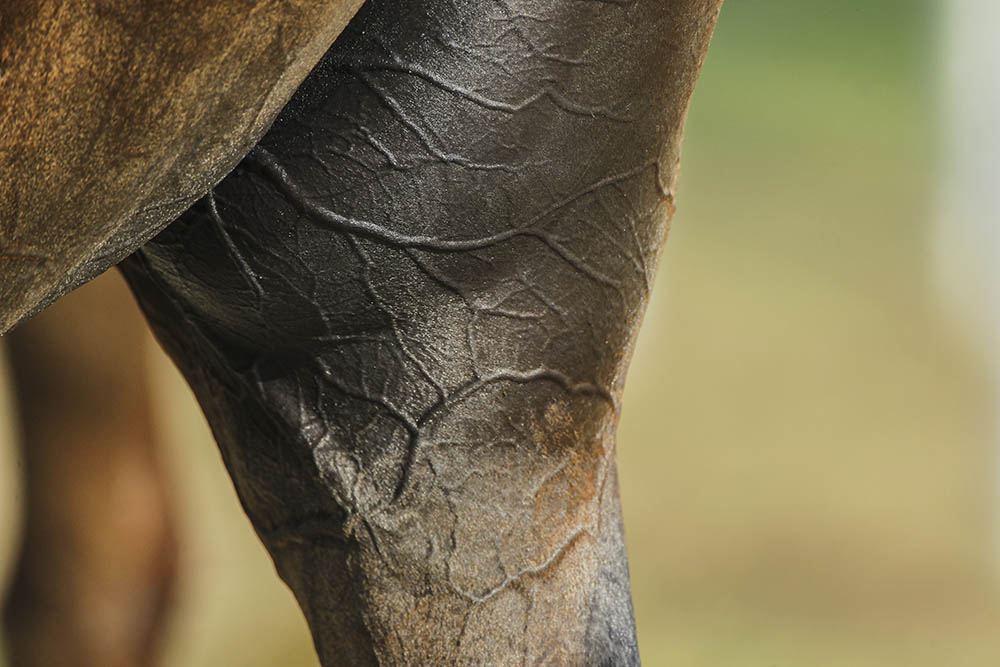While the hot Australian climate can be brutal and produce extreme temperatures that cause heat stress in horses, this dangerous condition can also be brought on by intensive exercise on an ordinary summer’s day.

“Humidity also plays a major role in the
horse’s ability to deal with heat stress.”
A normal horse’s temperature sits between 37.5 and 38.5°C, with most horses sitting in the 37.5-38.2 °C range. Illness and exercise can increase the body’s core temperature and cause problems with the normal physiological functioning of the body.
With exercise, the temperature rise is usually short-lived as the body utilises various biological methods to reduce heat and return the core temperature to an ideal level. (Increases in body temperature because of illness relate to the release of inflammatory mediators and the loss of thermoregulation, and can cause heat stress in the horse — but that will not be discussed in this article).
Heat stress should be thought of as the inability of the horse to lose excess body heat. If the heat cannot be effectively dissipated and the body temperature stays high, critical thresholds are surpassed and death can occur.
There are two major contributing factors to a horse becoming heat stressed; firstly, the body generates too much heat, and/or the body is compromised in its ability to lose this heat into the environment. Initially, the body generates heat during normal physiological activities such as eating and exercise, with the amount of heat being related to the type and the amount of chemical reaction occurring at a cellular level.
When horses are asked to exercise at high intensities, or over prolonged periods, the chemical reactions that occur in the muscles are inefficient and produce large amounts of heat relative to the amount of energy produced to make the muscles function. The body relies on several pathways to remove this heat from the body, but when these processes are overwhelmed, the system can fail. The usual physiological pathways that are activated when the core temperature rises include sweating, allowing the heat to be transferred into the sweat; dilation of skin blood vessels to allow heat to pass through the skin, and an increase in respiratory rate to transfer heat from the lungs into the exhaled air.
The environment can also facilitate the removal of the generated heat. This occurs if the ambient temperature and the humidity are low enough to allow transfer of heat from the hotter body to the cooler/drier environment. In environmental temperatures between 5°C and 25°C, the body can readily deal with maintaining an ideal temperature during intense activities.
When the temperature in the environment is high, heat is not readily able to be transferred from the body as the gradient (temperature difference) between the two is not big enough. Think of it like a glass of hot water: if the glass is put into a refrigerator, it will cool down quickly; if left in a hot room the water will remain hot for a much longer time.
Humidity also plays a major role in the horse’s ability to deal with heat stress as sweating is the predominant way a horse loses heat. If the humidity is high, sweat remains on the skin and the heat is not removed. If the air is dry or there are light winds blowing, the sweat is evaporated, removing the heat and cooling the horse down.
There are heat stress guides available that rely on adding the temperature (in Fahrenheit) and the relative humidity percentage together to give a figure which enables the rider/handler to predict the likelihood of the horse getting heat stress.
The Celsius temperature can be converted to a Fahrenheit value by multiplying it by 9/5 and adding 32. So, the formula is F = 9/5 x C + 32.
If the Heat Guide (temperature in Fahrenheit + relative humidity) is:
A) 120 or less: Exercise should not be a problem as the horse should easily be able to deal with generated heat.
B) 120-150: There is some compromise to the horse’s ability to cool down so program in some time to allow the horse to recover between exercises and do not over-exert.
C) 150-180: There are significant risks associated with intense work and overheating, so reduce work intensity and implement cooling strategies where possible.
D) 180+: Horses should NOT be exercised in these conditions. If exercise is undertaken, appropriate and adequate cooling procedures should be utilised frequently and without delay.

This guide does not consider the role that high radiation from the sun plays in increasing the risk of heat stress, and there are other guides that include this variable to assess this risk, an example being the Wet Bulb Globe Temperature.
There are several clinical signs that can occur if a horse is suffering from heat stress, and initially some of the signs are subtle and may be misinterpreted by the handler: if the horse starts to show signs of agitation or aggression after work, it may not be the horse just being naughty!
Clinical signs associated with heat stress include:
A. Sweating
B. Rapid breathing with flared nostrils
C. Elevated heart rate (60 + bpm) and rectal temperature (>40 C)
D. Agitation
E. Aggression
F. Refusal to eat or drink
G. Distress
H. Ataxia, weakness and staggering
I. Collapse

Colic has been associated with heat stress although this can be due to the dehydration that occurs as a result of heavy sweating and fluid loss. Synchronous diaphragmatic flutter (“thumps”) has also been linked to heat stress and occurs due to the electrolyte imbalance caused by exercise and sweating. In extreme cases where the body temperature remains too high for too long, the horse’s kidneys and other vital organs can shut down, resulting in multi-organ failure and death.
It should be mentioned that there is a condition seen in some horses, referred to as “anhidrosis”, where the horse is unable to sweat, or sweats minimally when the body temperature increases. It more commonly occurs in horses that change environments, going from a cold environment to a hot one, but occasionally horses bred in one area can suffer this disease. These horses show evidence of heat stress (increased respiratory rate, failure to cool off after exercise), without sweating. There is no treatment for this, and horses need to be managed with appropriate methods to cool them down post exercise or on extreme heat days (hosing, fans, clipping, shade). Often these horses are relocated to cooler climates to manage the condition.

“Ensure shade is
available to horses
in paddocks.”
TREATMENT
If heat stress is suspected, cooling the horse down ASAP is paramount. The most practical and effective way is to cold hose the horse and move it out of the sun immediately. Applying cold water to the skin allows the excess heat from the body to be transferred to the water, effectively heating the water. The use of scrapers to remove this warmed water and speed up the cooling process has been advocated by many in the past, however there is not a lot of evidence to support or refute this procedure. Constant hosing would deliver a similar effect to scraping (and can be safer to the handlers), essentially removing warm water and replacing it with cold water in one motion; ultimately it depends on how much water (and helping hands) you have available.
The use of fans will also help evaporate the water and decrease the core temperature; however, fans are not always readily available during a crisis.
If the possibility of heat stress following intensive exercise is anticipated, such as following an endurance leg or cross-country event, buckets of ice water can be prepared to throw over the horse once it finishes. Avoid applying wet towels and leaving them on, as they do not cool the horse effectively because the heat is transferred to the towel and, if not removed, keeps the heat on the skin.
Do not apply large blocks of ice to the hind quarters of the horse as this can reduce blood flow to these large muscle groups that rely on blood flow to remove the heat and the waste by-products that accumulate with intense exercise — which can ultimately cause other health issues if not removed. Areas over the large veins such as the neck (jugular veins), inside the front legs (cephalic veins) and inside hind legs (saphenous veins), are good sites to target with ice — however this is not as effective as applying cold water to the entire body, and cold hosing, as detailed above, should always be the first port of call.
Allow access to plenty of water. Often horses become depleted in electrolytes, but it has been shown that in the short term there is no advantage to giving electrolyte-laced water compared to giving plain water. Electrolyte water can be offered to the horse, but always have plain water available as well, as some horses are not used to the change in the taste and will not drink it. Electrolytes can be replaced once the horse is cooled, by using pastes, salt blocks or oral supplements.
If the horse is unable to, or refuses to drink, it may require IV fluids. If the horse is not too agitated but refuses to drink, there is the potential to give water and electrolytes by stomach tube, but this requires an experienced person to tube the horse to minimise the risk of a nosebleed, or other complications.
In severe cases, where a horse is markedly distressed or has collapsed, intravenous fluids will need to be administered.

MINIMISING THE EFFECTS OF HEAT
Preventing heat stress is far more desirable than having to treat the horse once it occurs. Careful planning and forethought will reduce the risk of heat stress in many situations.
A. Ensure horses are fit before they are asked to compete in high temperatures and have been conditioned for both the intensity of the exercise and the duration. Horses that attain fitness in cooler climates are better at dealing with heat than unfit ones.
B. Acclimatise the horse to the weather conditions. This is difficult to do when the weather suddenly changes to produce an abnormally hot day, but when several weeks of warm weather are predicted, slowly get the horse used to the heat. Work the horse in the morning or wait until the cool of the evening, and if necessary, gradually work up to warmer times of the day.
C. Do not overwork fat or overweight horses, as they have an increased risk of heat stress.
D. Clip horses if they have a long coat that interferes with their ability to lose heat through the skin. This is particularly important for horses with PPID (Cushings) and for horses that have relocated from a cold climate to a hot one.
E. If working in hot climates, introduce ways to cool your horse either whilst working or straight after work is complete; this includes shaded areas, water sprays and increased airflow.
F. Consultation with regulatory bodies to change the hours of the competition, bringing the starting times forward or reducing the time between events to minimise the time horses and handlers are standing around. Obviously, if horses are required to compete in multiple events, they should be allowed sufficient time to cool down in between, or restricted to the number of events they can compete in. On days of extreme heat, competitions, events, and races should be postponed or abandoned in the best interest of the horses’ welfare.
G. Travel horses in well-ventilated trucks/floats if they must be transported on hot days or over long distances.
H. Ensure shade is available to horses in paddocks.
I. Remember also that horses can become heat stressed on extreme temperature days without being exercised, so ensure barns and stables are well ventilated, or have fans to facilitate a breeze to help your horse cool down. EQ

